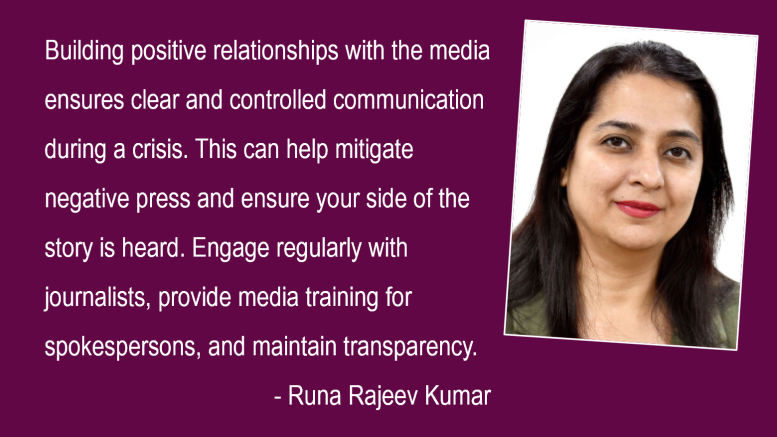In today’s digital age, an organisation’s reputation is more fragile than ever. A single social media post or news headline can spark a crisis, leading to damaged customer trust, financial losses, and a tarnished brand image. This is where Enterprise Risk Management (ERM) comes into play. ERM provides a structured framework to identify, assess, and proactively mitigate risks, safeguarding the organisation’s reputation.
Reputation risk, in particular, arises from negative stakeholder opinions or publicity regarding business practices, whether true or not. Such risks can lead to financial setbacks, customer attrition, or costly litigation. Through ERM, organisations can effectively mitigate these risks, with reputation risk being a top priority.
To manage reputation risk effectively, organisations must first understand its potential impact. By quantifying the financial consequences of a reputational crisis, businesses can better justify investments in prevention and mitigation strategies.
Reputation risk should be an integral part of an organisation’s overall risk management framework. Risks can be categorised into financial, geopolitical, technology, environmental, social, supply chain, information technology, regulatory, governance, reputation risks and many more. While governance risk is purely internal, other risks emerge at the intersection of internal and external actors and processes. Reputation risk stands out due to its potential to cause widespread and long-lasting damage. Unlike a data breach (operational risk) that can be contained, a public scandal (reputation risk) can have a domino effect, impacting everything from customer loyalty to stock prices.
Understanding these interlinkages of risks is crucial for developing a holistic ERM strategy that addresses potential threats from multiple angles and prepares organisations to manage crises that could damage their reputation. ERM frameworks like Committee of Sponsoring Organisations (COSO) and ISO 31000:2018 provide a structured approach to risk management but often require adaptation to address the unique challenges of reputation risk effectively.
While ERM frameworks provide a roadmap, true reputation risk management goes beyond following a checklist. Here are steps to cultivate a proactive approach:
Identify Reputation Gaps: Understand that reputation is based on perception. Regularly assess how different stakeholders perceive your organisation. Are there inconsistencies between your organisation’s image and reality? Address these gaps to strengthen your reputation.
Develop Strong Internal Coordination: Poor coordination among business units can lead to reputation risk. Effective internal communication ensures that expectations are aligned and changing beliefs are managed.
Monitor Your Reputation Landscape: Continuously track media coverage, social media sentiment, and stakeholder concerns. Early detection of potential issues allows for swift action, minimising reputational damage. Utilise media monitoring tools like Online Reputation Management and Meltwater to track news mentions and gauge online sentiment.
Develop Strong Media Relations: Building positive relationships with the media ensures clear and controlled communication during a crisis. This can help mitigate negative press and ensure your side of the story is heard. Engage regularly with journalists, provide media training for spokespersons, and maintain transparency.
Evaluating an organisation’s reputation can be done through media analysis, stakeholder surveys, and public opinion polls. Media analysis is particularly important as the media shapes stakeholder perceptions. Develop a crisis communication plan to prepare for potential crises and establish clear communication channels. Build strong relationships with stakeholders to foster trust and transparency. Monitor social media and online reputation to stay informed about public sentiment and address issues promptly. Invest in employee training to empower your workforce to be brand ambassadors and crisis responders. Mitigation strategies should be tailored to the specific risks identified.
A well-executed crisis management plan is essential for mitigating the impact of a reputational crisis. It involves having a clear chain of command, designated spokespersons, and pre-approved messaging. Regular crisis communication drills ensure a coordinated and effective response. Moreover, having a social media crisis management plan is crucial. Social media can amplify a crisis, but it can also be a platform to rebuild trust.
A strong reputation is built on trust and credibility. Organisations must cultivate a culture of ethical behaviour, transparency, and accountability.
The landscape of risk is constantly evolving. Emerging threats such as cyberattacks, advent of AI climate change, and geopolitical instability can pose significant challenges to reputation. Organisations must stay ahead by continuously monitoring the environment and adapting their risk management strategies accordingly.
The views and opinions published here belong to the author and do not necessarily reflect the views and opinions of the publisher.



Be the first to comment on "Safeguarding your Brand: A comprehensive approach to Reputation Risk Management"